
* As an initial step in bringing helicopters into the turboshaft age, the Sikorsky company decided to develop two turbine helicopters: the twin-engine S-61 Sea King and the single-engine S-62, both of similar configuration but on different scales. The S-62, which flew first, was only modestly successful, but the Sea King would prove highly successful as a naval helicopter in a range of roles, with a number sold to civilian operators as well. The S-61 would also lead to the "S-61R Jolly Green Giant" for the US Air Force, which performed excellent service in the Vietnam War.
* Although the helicopter had come of age by the early 1950s, the machines available at the time were all dependent on piston engines -- which left something to be desired, in particular for larger helicopters. The introduction of reliable turboshaft engines during that decade gave helicopters a more powerful and compact powerplant, with a power-to-weight ratio roughly five times greater than a piston engine. In 1957, the Sikorsky helicopter firm committed to the development of two new helicopters, based on turboshaft power: the "S-61", with twin engines, and the "S-62", with a single engine, the General Electric (GE) T58 being the powerplant in both cases.
While both design efforts were begun roughly in parallel, the S-62 was on a faster track, since the US Coast Guard (USCG) had an immediate need for a search-&-rescue (SAR) helicopter, to replace the antiquated Sikorsky HH-19G (S-55). The USCG wanted a single-engine helicopter as soon as possible, and so Sikorsky designed the S-62 using the dynamic system and a number of subsystems of the piston-powered S-55, incorporating them in a new airframe and using a T58 turboshaft as the powerplant. First flight of the "S-62A" prototype was on 14 May 1958, with certification following in June 1960, and initial delivery to a commercial customer later that year. The USCG had decided to obtain what would become the Kaman Seasprite, and so did not order the S-62.
The S-62 was made mostly of aircraft aluminum alloy. It was of conventional main-tail rotor configuration, with a three-bladed main rotor and a two-bladed tail rotor on the left side of the tailfin, a tailplane being fitted on the other side of the tailfin. It was powered by a T58-110-1 turboshaft -- civilian designation CT58-110-1 -- with 930 kW (1,250 SHP), mounted on the roof of the fuselage. The fuselage was of amphibian configuration, with taildragger landing gear; all landing gear had single wheels, the tailwheel being fixed, each main gear tucking up backwards into sponsons on each side of the forward fuselage. There were no gear doors on the bottom of the sponsons; they looked like floats, but their intended purpose was to provide a streamlined storage space for the landing gear.
____________________________________________________________________
SIKORSKY S-62A:
____________________________________________________________________
main rotor diameter:
16.16 meters (53 feet)
tail rotor diameter:
2.67 meters (8 feet 9 inches)
fuselage length:
13.58 meters (44 feet 6 inches)
footprint length:
13.86 meters (45 feet 6 inches)
height (to top of rotor head):
4.33 meters (14 feet 2 inches)
empty weight:
2,248 kilograms (4,957 pounds)
MTO weight:
3,583 kilograms (7,900 pounds)
max cruise speed:
148 KPH (92 MPH / 80 KT)
service ceiling:
2,010 meters (6,600 feet)
hover ceiling (out of ground effect):
1,770 meters (4,600 feet)
range, max fuel:
743 kilometers (462 MI / 400 NMI)
____________________________________________________________________
There was a rearward-sliding door on the right side. Standard crew was two, with airliner-type seating for ten, or more austere seating for a dozen. The S-62 was not really designed for operating off the water; the amphibian capability was intended mostly to cope with emergencies. Along with the S-52B, Sikorsky flew a single "S-62B", which was similar to the S-62A, but used the rotor system of the Sikorsky S-58.
Commercial sales were not enough to allow Sikorsky to make a profit off the S-62 -- but in 1962, the Coast Guard decided to not acquire the Kaman Seasprite after all, and ordered the S-62 instead, with Sikorsky configuring the machine as per USCG spec as the "S-62C". Initial deliveries of the "HH-52A Seaguard" were in 1963; it had originally been designated "HU2S-1G", but in 1962 the Pentagon acquired a common designation system, with the designation being changed accordingly. A total of 99 was built, with the last delivered in 1962.
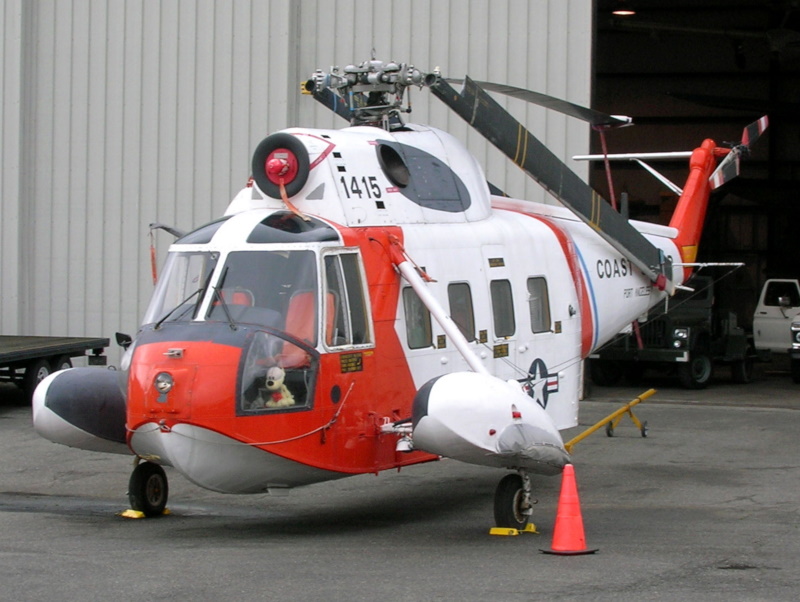
The HH-52A was much like the stock S-62A, but added an automatic stabilization system, to allow it to hover more precisely while performing rescue winch operations. It also featured militarized avionics, though not a radar; and of course rescue kit, including a platform that could be deployed during water landings -- it is unclear if that capability saw much use. The Seaguard gave excellent service into the late 1980s, being finally phased out in favor of non-amphibious types such as the HH-65 Dolphin.
Total production of the S-62 is given as 171 machines, including a number of "S-62J" helicopters built in Japan by Mitsubishi. A handful of S-62Js was flow by the Japanese Air and Maritime Self-Defense Forces (JASDF & JMSDF) for SAR. Other government users included the Philippine Air Force, the Royal Thai Police, and the Icelandic Coast Guard. It is unclear if any S-62s are still flying; a number survive on static display.
BACK_TO_TOP* During the Cold War, to counter the threat of Soviet Red Navy submarines, the US Navy acquired a range of antisubmarine warfare (ASW) assets. Helicopters had been seen as useful for the ASW mission from their inception, but early helicopters didn't have the lift capability to carry adequate loads. As a result, the Navy had to use "hunter-killer" teams, with one helicopter carrying ASW gear to track down submarines, and the other carrying depth charges or homing torpedoes to destroy them.
The introduction of turboshaft power for helicopters in the 1950s gave the prospect of combining the hunter and killer roles in the same rotorcraft. The Navy issued a requirement to that end, with Sikorsky granted a contract in 1957. The first prototype of the "Sea King", designated "XHSS-2", performed its initial flight on 17 March 1959 -- almost a year after the initial flight of the S-62 -- this machine being powered by twin T58-GE-6 turboshafts, providing 785 kW (1,050 SHP) each.
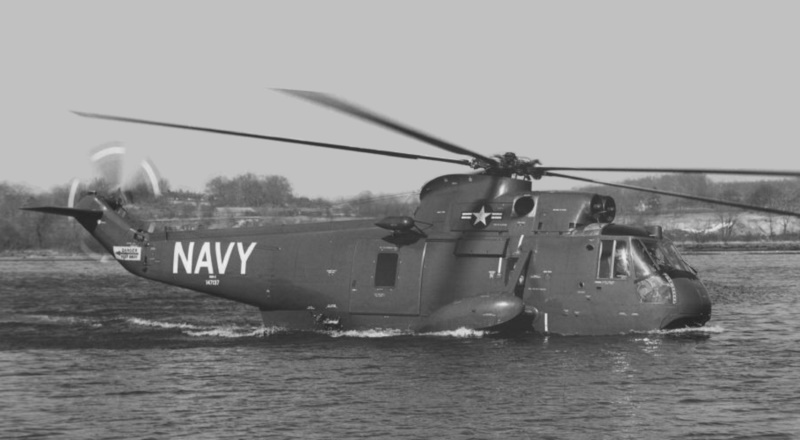
The prototype was followed by nine "YHSS-2" pre-production machines. There were no major hangups in trials, with the first deliveries of "HSS-2" production machines in the fall of 1961. With the Pentagon designation change in 1962, the HSS-2 became the "SH-3A", with the pre-production machines being redesignated "YSH-3A".
The SH-3A looked like a scaled-up, twin-engine version of the S-62, though the relationship between the two machines was somewhat indirect -- there was little or no parts compatibility between them, they simply featured a similar configuration. The SH-3A was built mostly of aircraft aluminum alloy and was of conventional main-tail rotor configuration, with an amphibian hull for water landings. There was a window on each side, with a crew door behind the cockpit on the left side, and a forward-sliding door with a window on the rear right side. A rescue hoist could be fitted above the sliding door.
Like the S-62, the SH-3A had taildragger landing gear, with a fixed tailwheel and the main gear retracting back into sponsons -- but the SH-3A's main gear assemblies had two wheels each, not one. External stores could be carried on the strut between a sponson and the fuselage. The SH-3A was originally powered by twin General Electric T58-GE-6 turboshafts, driving five-blade main and tail rotors, with aluminum blades featuring a leading-edge spar and honeycomb fill. The tail rotor, as with the S-62, was on the left side of the tailfin, with a tailplane on the right side.
The mounting of the engines on the top of the fuselage mean it was easier to maintain weight trim; it also meant an open connection between the cockpit and the cabin, the mounting of the engine in the nose in the Sikorsky S-55 and S-58 having meant a raised cockpit relative to the cabin.
Following initial production, the T58-GE-8B turboshaft, each engine providing 940 kW (1,250 SHP), was introduced into manufacture. Production was eventually updated to the T58-GE-8F, with the same power ratings but technical improvements. An intake filter box to deal with ice or dirty environments was eventually developed, though it doesn't seem to have been a normal fit.
The main rotor featured automatic folding using a hydraulic system. As with the S-62, the S-61 was not really suited to operations on water, the amphibious capability being used only in emergencies. Performance was excellent, with a stripped-down Sea King, featuring streamlined skids in the place of the undercarriage sponsons, setting a speed record of 339.1 KPH (210.6 MPH) in 1961 -- though the record would be broken a year later. This demonstrator, incidentally, would remain in trials service, its career including conversion to a helicopter gunship configuration.
The SH-3A's primary sensor was the Bendix AN/AQS-10 dipping sonar, with an AN/APN-130 doppler radar altimeter, coupled to a Hamilton Standard autostabilization system, used to maintain vertical station -- early machines didn't have doppler, but they were retrofitted with it. Similarly, early machines didn't have inflatable flotation gear on the sponsons, but they were also updated with it. Offensive armament was up to four Mark 46 or Mark 48 homing torpedoes; four depth charges or a single nuclear depth charge could be carried as alternative stores, but that wasn't the norm. Some SH-3As may have been refitted with the AN/AQS-13 dipping sonar, the primary improvement being a longer line for deeper sonar depth.
The SH-3As were typically painted dark blue overall, with dayglo noses -- and often dayglo tailfins, implemented later. They would occasionally have other color schemes, with three-tone camouflage or battleship gray applied to some serving in Southeast Asia.
* A total of 245 SH-3As was produced, not counting the prototype and pre-production machines, that sum including a number of subvariants:
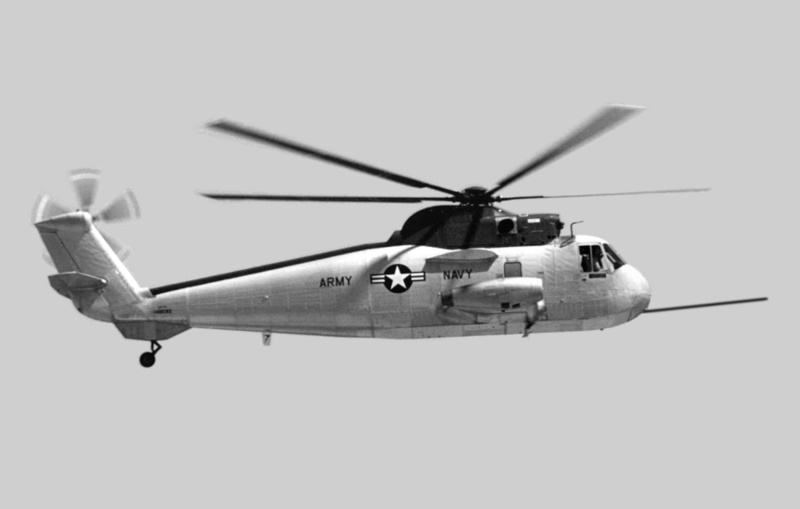
A number of SH-3As were used for other trials. One was fitted with exhaust baffles, along with an intake filter, as a noise-reduction experiment; while another was fitted for blind flying by the US National Aeronautics & Space Administration (NASA), with daylight and infrared cameras plus a TV display. The blind-flying machine was later used for other trials for kit being evaluated for other S-61 versions. The large number of SH-3As built also provided a feedstock for conversion into later variants, as discussed later.
* The "CH-3B" was really just the SH-3A in US Air Force service. The USAF acquired three SH-3As from the Navy in 1962, stripping out the ASW gear and flying them from Otis Air Force Base (AFB) in Massachusetts for support of offshore radar platforms, the "Texas Towers". They were redesignated "CH-3A", but not for long; the USAF liked them so much that the service ordered three more as CH-3Bs, changing the designation of the first three as well to differentiate them from Navy machines. They were left in shiny natural metal finish.
One of three CH-3Bs built for the Air Force performed a trans-Atlantic flight -- from Otis AFB to Paris, France -- from 27 May to 5 June 1963, with five stops in all, setting a record for the time. One CH-3B ended up in civilian hands as a "flying crane", after the retirement of the fleet from Air Force service.
BACK_TO_TOP* There never was an "SH-3C" (or an "SH-3E"); there was a "CH-3C" (and a "CH-3E"), but they weren't really Sea Kings, and are discussed later. That means the next in the Sikorsky Sea King series was the "SH-3D", a refined ASW variant.
Primary changes were T58-GE-10 engines, providing 1,050 kW (1,400 SHP) each, with an uprated transmission to handle the greater power, and consequently a greater maximum take-off weight; an AN/ASQ-13 dipping sonar, much superior to the AN/ASQ-10 it replaced; and generally updated avionics.
The SH-3D had an additional fuel tank and a wider-span, braced tailplane; armament was reduced to two homing torpedoes, but the carriage system was refined to be more flexible. Some SH-3Ds apparently hauled a MAD bird, with the extended right sponson for the winch, and presumably the extended left sponson for the smoke / dye markers. It did not have sonobuoy launch tubes.
____________________________________________________________________
SIKORSKY SH-3D:
____________________________________________________________________
main rotor diameter:
18.9 meters (62 feet)
tail rotor diameter:
3.15 meters (10 feet 4 inches)
fuselage length:
16.69 meters (54 feet 9 inches)
footprint length:
22.15 meters (72 feet 8 inches)
height (to top of rotor head)
4.72 meters (15 feet 6 inches)
empty weight:
5,382 kilograms (11,865 pounds)
MTO weight:
9,300 kilograms (20,500 pounds)
max cruise speed:
265 KPH (165 MPH / 145 KT)
service ceiling:
4,480 meters (14,700 feet)
hover ceiling (in ground effect):
3,200 meters (10,500 feet)
hover ceiling (out of ground effect):
2,500 meters (8,200 feet)
range, max fuel:
1,005 kilometers (625 MI / 545 NMI)
____________________________________________________________________
A single "YSH-3D" prototype was built, being derived from an SH-3A that hadn't got off the production line, with 72 production machines for the US Navy following, the variant going into service in 1966. Two SH-3Ds were also built by conversion of SH-3As; they didn't have the wider-span tailplane.
Six SH-3Ds were exported to Spain, while good numbers of similar machines were exported or built under license, as discussed later. Along with their US Navy fleet service, SH-3Ds also provided highly visible, if intermittent, support for the US crewed space program, recovering Apollo astronauts.
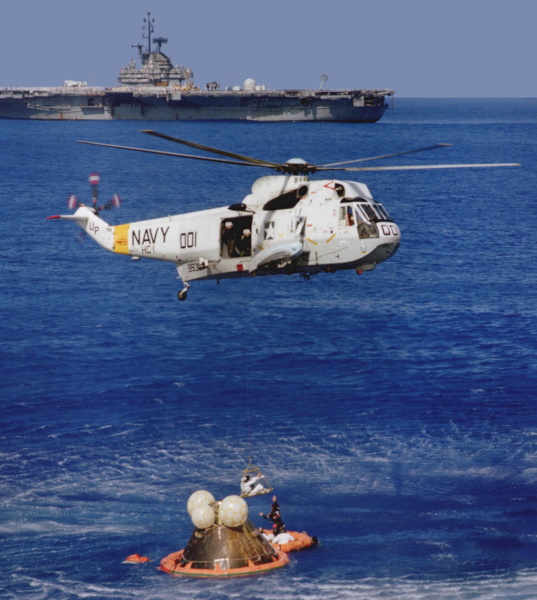
From 1987, Sikorsky implemented a "service-life extension program (SLEP)" for the SH-3D, providing kits that were installed at Navy maintenance depots. The SLEP included:
There are tales a half-dozen SH-3Ds were converted to a CSAR configuration like that of the HH-3A -- but if so, they were not redesignated "HH-3D". The only SH-3D subvariant ended up being the "VH-3D", which replaced the VH-3A in the presidential VIP helicopter role. There had been plans to replace the VH-3As with bigger Sikorsky S-65s, but S-65s were desperately needed for the Vietnam War -- and so 11 new-build VH-3Ds were obtained instead, going into service in 1976. They were kitted up much like the VH-3As, with a luxury interior and additional communications kit; they could be distinguished by a small dome antenna on top of the rear fuselage.
A VH-3A was used to trial elements of the VH-3D, this machine being designated "NVH-3A"; a VH-3D was eventually similarly used for trials and demonstrations as the "NVH-3D". The VH-3Ds proved persistent beyond all expectation, flying on well after the Sea King was out of operational US military service. That was partly due to difficulties in finding a replacement -- a complicated story, not to be related here. The bottom line is that they are to be replaced by the Sikorsky VH-92, which can be thought of as a design descendant of the Sea King; the VH-3Ds should finally be retired before the end of the current decade.
* The SH-3D replaced the SH-3A in the ASW role, but the SH-3As were still otherwise perfectly serviceable helicopters; as a result, 103 SH-3As, plus two SH-3Ds, were eventually converted to "SH-3G" SAR-utility transport configuration, with the sonar system yanked out -- it could be re-installed if necessary -- and reconfigured with 15 canvas seats; a reinforced floor; plus long-range fuel tanks. Most had the short sponsons of the SH-3A. 12 were supplied to Spain.
All were fitted with T58-GE-10 turboshafts; they could haul external tanks inboard of the sponsons, and all featured a "refuel-while-hover" system. All could be fitted with a door gun -- typically an M60 7.62-millimeter light machine gun, but a few could carry a 7.62-millimeter Gatling Minigun. A half-dozen were fitted with gun pods, presumably inboard of the sponsons, for CSAR duties, though not redesignated "HH-3G"; a few were converted to VIP heli-liners for Navy brass, though not redesignated "VH-3G". Two SH-3Gs were used by the Naval Weapons Test Center in China Lake, California, for various trials, to be given the special designation of "YSH-3J". The SH-3Gs gave excellent service in the First Gulf War.
* A more ambitious upgrade effort followed the SH-3G, this set of upgrades being designated "SH-3H", most being derived from SH-3Gs. Along with airframe and engine component replacements, such as fit of T58-GE-10 turboshafts and the uprated SH-3D gearbox when necessary -- it also appears intake filters were fitted as standard, with two configurations of filters -- the SH-3H update featured:
Other avionics were updated across the board -- radios, navigation systems, identification friend or foe (IFF), and so on. The radar and ESM systems were later deleted, the rotorcraft then being updated with an improved tactical navigation system, along with improved sonar processing capability. Finally, the SH-3H had an additional window forward on the left side of the fuselage, as per a handful of SH-3As.
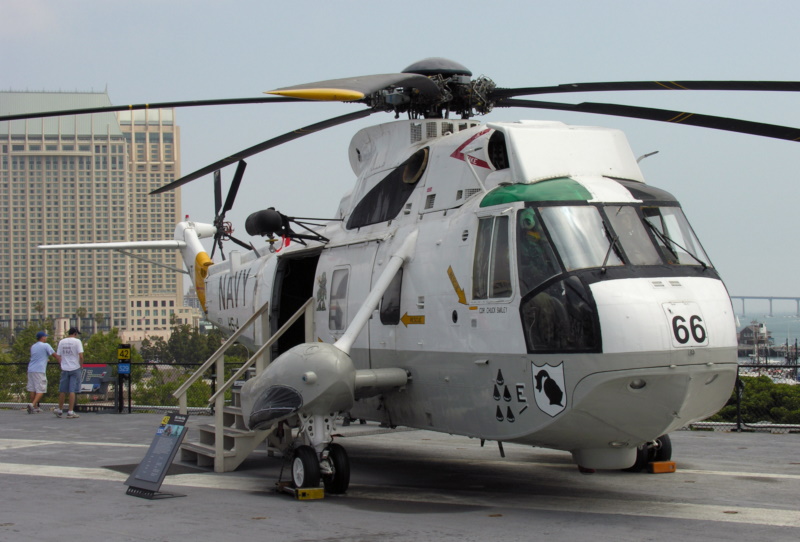
The SH-3H could be thought of as an improved "multirole" SH-3D, required when the US Navy retired its dedicated ASW carriers. The SH-3H could not only perform the ASW mission, but also support the "plane guard" mission -- fishing pilots out of the sea who went into the drink during carrier operations -- and be convertible to utility service. 163 SH-3Hs were obtained by conversion from 1971, mostly of SH-3Gs, but also of a number of SH-3As and SH-3Ds that hadn't been converted to intermediate variants. Those derived from SH-3Gs could carry external tanks.
From the late 1980s, the US Navy Sea King fleet was drawn down, mostly being replaced by the Sikorsky Sea Hawk, with survivors increasingly used in the transport-utility role. From 1992, at least 26 SH-3Hs were stripped of their ASW gear, to be put into the utility role under the designation of "UH-3H". The last US Navy Sea King was retired in 2010.
BACK_TO_TOP* Sikorsky also wanted to sell the S-61 on the commercial market, performing the first flight of the "S-61L" on 6 December 1960, with introduction to service in early 1962. The S-61L was stretched by 1.3 meters (4 feet 3 inches) to 9.73 meters (31 feet 11 inches), increasing passenger or load capacity; the higher unequipped weight was tolerable, since the S-61L didn't need to carry the load of combat systems. It was a "heli-liner" configuration, with 11 passenger windows on both sides.
The S-61L dispensed with the sponsons, instead featuring fixed main landing gear, each gear assembly with twin wheels; it also had a wider-span tailplane, and a modified rotor head. Early production was fitted with GE CT58-100 turboshafts, the civil equivalent of the T58, with 1,005 kW (1,350 SHP) each. Sikorsky offered a three-engine version, but nobody bit on the concept, and it remained unflown.
The S-61L could carry a maximum of 25 passengers and a flight attendant. The rearmost two seats could be removed in favor of a toilet, and a forward seat could be removed for a hot-meal galley. There was a baggage hold behind the cockpit, with a door on the left. The crew / passenger door arrangement was a cargo door on the front right side of the fuselage; an "airstair" door towards the right rear fuselage; emergency exits on both sides, in a line with the rotor hub; and an emergency exit / service door on the left rear fuselage. However, there appears to have been some variation in door configuration, photos showing some of these machines having the airstair door on the front right fuselage. Possibly they were mockups.
____________________________________________________________________
SIKORSKY S-61L:
____________________________________________________________________
main rotor diameter:
18.9 meters (62 feet)
tail rotor diameter:
3.15 meters (10 feet 4 inches)
fuselage length:
17.96 meters (58 feet 11 inches)
footprint length:
22.2 meters (72 feet 10 inches)
height (to top of rotor head):
5.18 meters (17 feet)
empty weight:
5,217 kilograms (11,500 pounds)
MTO weight:
8,620 kilograms (19,000 pounds)
max cruise speed:
240 KPH (150 MPH / 130 KT)
service ceiling:
3,720 meters (12,200 feet)
hover ceiling (in ground effect):
2,743 meters (9,000 feet)
hover ceiling (out of ground effect):
1,190 meters (3,800 feet)
range, max fuel:
725 kilometers (450 MI / 410 NMI)
____________________________________________________________________
The S-61L was accompanied in sales by the "S-61N", the first of which performed its initial flight on 7 August 1962. It was much the same as the S-61L, but retained the sponsons -- though they were enlarged compared to those of the military S-61s. They also had weather radar as standard, mounted in a radome on the left side of the nose.
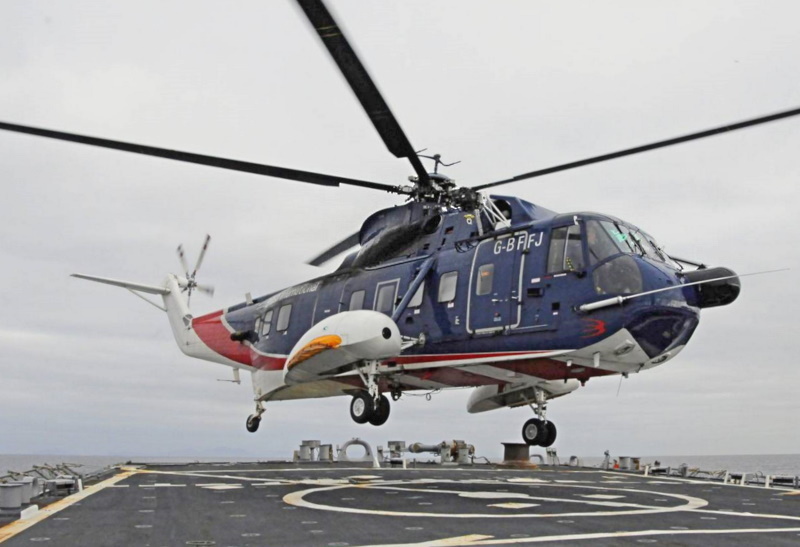
The S-61N was intended for overwater operations, particularly oil rig support -- but some did end up in government coast guard / SAR operations, featuring a sliding forward door with a rescue winch, plus bulged observation windows. They were also sometimes used on military contract. Incidentally, at the outset both the S-61L and the S-61N were simply "S-61s", only acquiring distinct designations later.
Both the S-61L and S-61N were subsequently updated to "Mark II" configuration, featuring improved CT58-140 engines, with 1,120 kW (1,500 SHP) each, and other small refinements. Another civil model, the "S-61 Payloader", was also introduced, being much like the S-61L, but stripped down to perform the "flying crane" role. Total production of the civil S-61s is cited as 119 machines.
* The S-61 is still going strong in the civilian market, thanks to refurbishment of machines made for civilian and military service by Carson Helicopters of Perkasie, Pennsylvania. Carson offers airframe refurbishment, with enhancements such as composite rotor blades, a "glass cockpit", fixed landing gear, a new cargo door, updated interiors, and so on.
The company has updated S-61L and S-61N machines, with an emphasis on the fire-fighting role, using a pack attached under the belly behind the main landing gear, with tanks and dump kit. Such fire-fighting conversions are called "Fire Kings". Carson offers to cut down the fuselage of these "long" civilian machines, returning them to the length of the SH-3, reducing weight for those customers who don't need the internal volume.
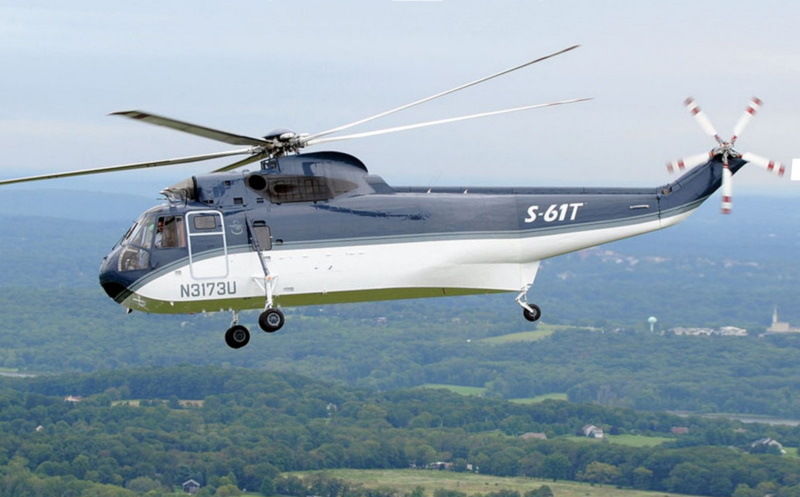
Carson has updated retired military S-61s as well, under the designation of "Super SH-3" -- or "S-61T Triton" as Sikorsky calls them, the two firms having collaborated on the update. In 2010, the US State Department signed a contract with Sikorsky to obtain up to 110 S-61T machines in support of operations in countries like Afghanistan where ground travel was risky. The State Department machines were to have provisions for armor, defensive countermeasures, and door machine guns. However, only 18 were delivered before the program was canceled, due to delays and changing circumstances. They were sold off from 2019, some having been delivered straight to storage. However, the State Department also obtained 16 refurbished S-61Ns, and it appears they remain in service.
BACK_TO_TOP* Sikorsky sold a number of Sea Kings to foreign customers. The first customer was the Danish Air Force, which obtained eight "S-61A-1" and one "S-61A-5" Sea Kings, with operations from 1966. The Danish Sea Kings were maritime SAR machines, based on the USAF SH-3B, with four windows on each side -- the last being a bubble window -- and a radome on the left side of the nose.
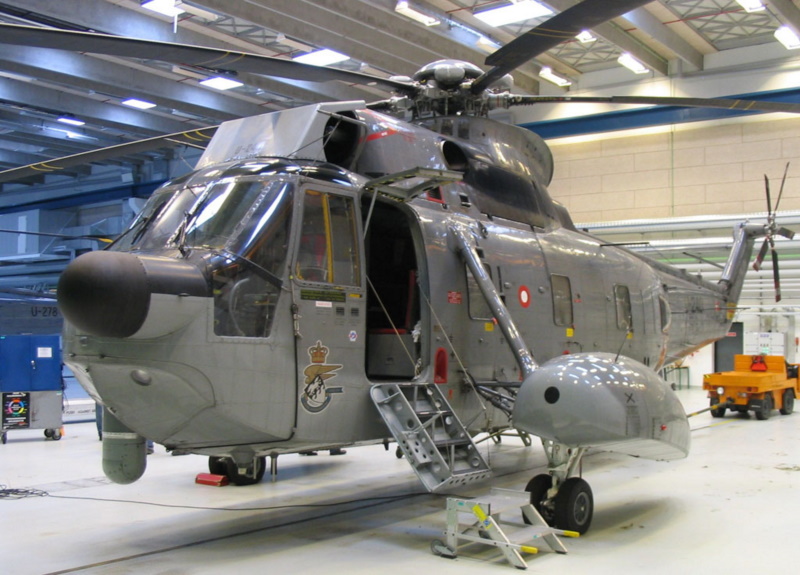
The two Danish subvariants were identical except for minor details. From the late 1980s, they were fitted with a forward-looking infrared (FLIR) turret on the nose, plus modernized avionics. They had were replaced by the Leonardo AW101, with the final flight of a Danish Sea King in 2011.
* Malaysia obtained a total of 46 "S-61A-4" Sea Kings, with initial deliveries in 1967. They also obtained two Sea King S-61N VIP transports from Agusta of Italy. The S-61A-4 machines were utility transports, generally similar to the USAF CH-3A/B machines, all fitted with a rescue winch.
35 survivors, plus the two S-61Ns, were put through a structural and avionics upgrade in the early 1990s, the new kit including a Sperry Primus 500 weather radar. Malaysia put them through a second refurbishment program, with updated avionics and mission system, plus a cockpit compatible with night-vision goggles. Malaysian Sea Kings are now to be replaced, but the new helicopter has not yet been identified.
* As mentioned earlier, six new-build SH-3Ds were sold to Spain, being originally designated "Z.9" and then "HS.9" in Spanish service. One was converted to an airborne early warning (AEW) configuration, like that of the Westland Sea King AEW.2 -- see next chapter -- this being the only Sikorsky-built AEW Sea King.
The Spaniards then obtained 12 SH-3Gs, designating them "Z.9A" and later "HS.9A". They were eventually updated to SH-3H standard -- presumably being redesignated "HS.9B", though sources are not clear on that issue; images show that at least some of them were updated with an imaging turret, mounted on the right side of the nose. Except for the AEW machine, most were eventually stripped down for use in the transport-utility role. The Spanish Sea Kings are now being replaced by the NH90.
* Four "S-61D-2" Sea Kings were provided to Britain, these being pattern machines for production in the UK by Westland, as discussed in the next chapter. Brazil obtained six "S-61D-3" machines, very much like the SH-3D. Brazil later acquired four Agusta-built ASH3-D machines and then two hand-me down US Navy SH-3Ds. They were all eventually brought up to a common specification, with improved avionics and the ability to carry two French AM39 Exocet antiship missiles. They are now being replaced by the Sikorsky S-70B Sea Hawk.
Argentina obtained five "S-61D-4" Sea Kings, one configured as a VIP transport, with four more "AS-61D" machines later acquired from Agusta of Italy. Some of these Sea Kings were stripped for use as utility helicopters. In 2008, Argentina acquired four hand-me-down refurbished UH-3H helicopters, plus two spares hulks. Argentine Sea Kings remain in service for now.
* Canada ordered 41 Sea Kings in late 1961, with the first of these "CHSS-2" machines being delivered in 1963. They were generally comparable to the SH-3A, being intended for operation from Royal Canadian Navy destroyers; noticeable differences were an automatic tail-folding scheme, plus a deck "beartrap" or "harpoon" system, permitting the helicopter to hook up to the destroyer deck and then, in effect, winched down to it. They were built by Sikorsky, but only sort of; the first three were provided from the Sikorsky production line, while the rest were assembled at the Pratt & Whitney factory in Quebec -- which was, like Sikorsky, part of the United Aircraft umbrella organization.
These machines were redesignated "CH-124" in 1970, following the consolidation of Canada's three military services into a combined armed forces structure. Incidentally, the consolidation didn't stick: in 2011, the combined forces structure was broken down again into the original three armed services.
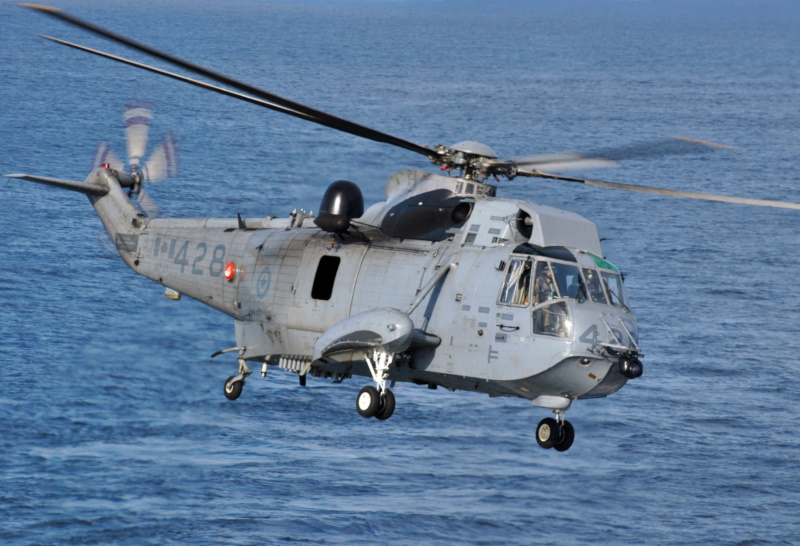
Three of the CH-124s were stripped down for the SAR / utility role, being informally designated "CH-124U". In the mid-1970s, 35 survivors were upgraded to "CH-124A" standard, under the "Sea King Improvement Program (SKIP)". The upgrade featured a crashworthy fuel system, main rotor de-icing, and an AN/APS-503 radar in a "beehive" radome on the machine's spine behind the engine nacelles -- much like some of the British Westland Sea Kings, described in the next chapter; these were the only Sikorsky-made Sea Kings with the beehive radome. Some had 15 prominent sonobuoy dispenser tubes under the rear fuselage.
Six were updated to "CH-124B" specification in the late 1980s, featuring updated avionics, particularly a "Helicopter Towed Array Support (HELTAS)" sonar system, replacing the dipping sonar. In the early 1990s, they were further refined to "CH-124B2" standard. There was also a single "CH-124C", used for trials.
During the First Gulf War in the 1990s, CH-124s were converted to a frontline combat configuration, featuring defensive countermeasures, a FLIR turret on the nose, and a 5.56-millimeter machine gun on a pintle mount in the right cockpit door. Crews were given desert survival kits. They were used primarily for naval blockade enforcement, checking out shipping bound into Iraq. These machines were initially supposed to be redesignated "CH-124C", but it didn't happen.
By that time, the Canadian Sea Kings were generally out of the ASW business, being used for SAR and as utility transports. It has now been replaced by the Leonardo AW101 in the shore-based SAR role, the AW101 being known as the "CH-149 Cormorant" in Canadian service. It has been replaced in shipboard service by the multirole Sikorsky H-92, known as the "CH-148 Cyclone" in Canadian service; the Sea King was completely out of Canadian government service at the end of 2018.
That is a very glib and sanitized read of the acquisition programs for the Cormorant and Cyclone -- both of which proved nightmares best not discussed here. In any case, 15 of the retired CH-124s and associated parts inventories were bought up by Rotor Maxx Support LTD of British Columbia, which provides support for S-61s, and operates a commercial fleet of them as well. The old CH-124s will be refurbished and given modest updates.
Ireland never actually purchased the Sea King, but from the 1990s the Irish Coast Guard operated a fleet of six S-61Ns in the SAR role -- these machines being leased on contract with a civil helicopter operator, CHC Helicopters of British Columbia, Canada. They were retired in 2013, being replaced by Sikorsky S-92s.
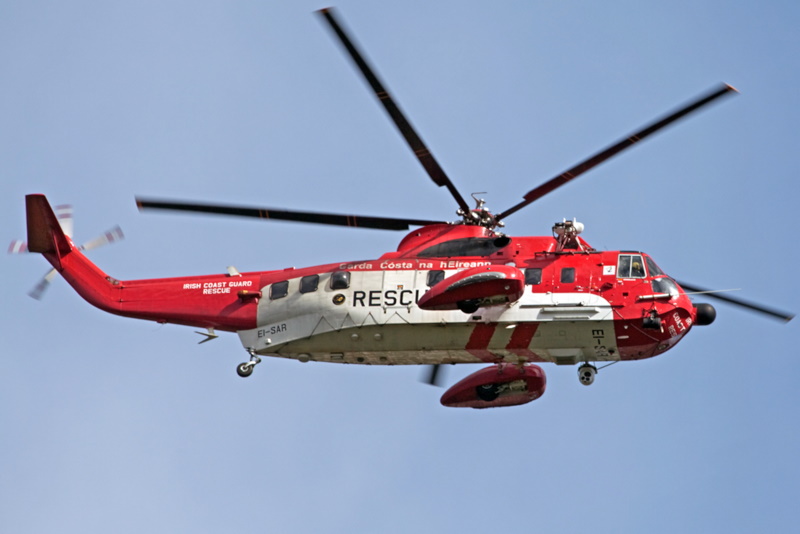
* Along with Sikorsky's foreign sales of the S-61, the machine was also built under license in other countries. The most enthusiastic of the license-builders was Westland of the UK -- which produced a parallel line of Sea Kings, in good quantities and in a range of variants. Westland production is a topic unto itself, and discussed later.
Agusta of Italy built a fair number of Sea Kings under license, starting with the "AS-61A-4", which at baseline appears to have been a utility version of the SH-3A, with four obtained by Venezuela. However, 20 more were sold to Iran in a maritime warfare configuration, with a radome offset on the nose to the left.
Agusta built a set of similar VIP-configured "AS-61-TS" machines, the "TS" meaning "Transport Special". Two were obtained by the Italian Air Force -- one used for hauling the Pope -- and others obtained in single or small quantities by Iran, Iraq, Libya, and Saudi Arabia. In addition, as mentioned earlier, Agusta built two "S-61N" Sea Kings for Malaysia -- these machines being like the civil Sikorsky S-61N, but with the shorter fuselage of the SH-3A.
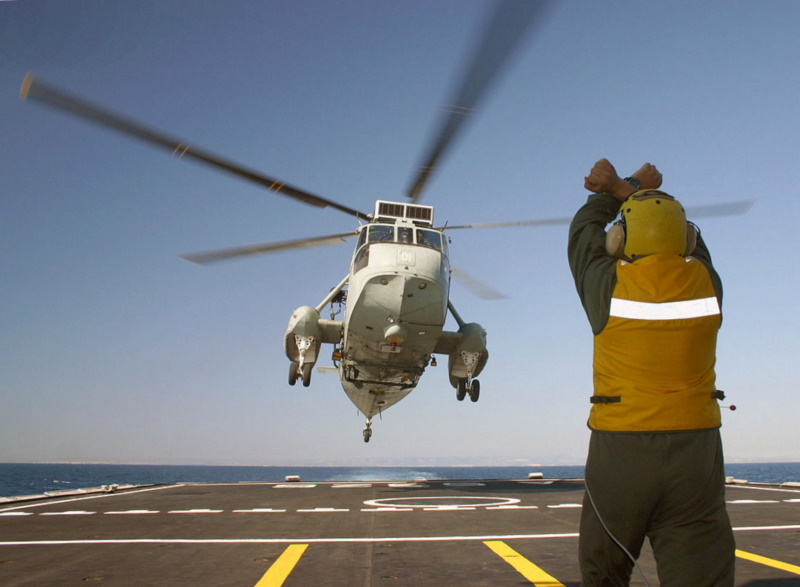
The Italian Navy obtained 24 "ASH-3D" Sea Kings, like the SH-3D but with an improved tailplane and T58-GE-100 engines with 1,120 kW (1,500 SHP) each. They had radar -- variously mounted in the nose or in a ventral drum, these being the only Sea Kings with the ventral drum radome -- and could carry two Exocet or Marte Mark 2 antiship missiles. Initial deliveries were in late 1968.
A dozen Italian survivors were eventually updated to "ASH-3H" standards, like the SH-3H. Late in their lives, a half-dozen were updated to an assault transport configuration. Italian Sea Kings were replaced by the Leonardo AW101, with the last Italian Navy Sea King retired in 2013. Ten ASH-3D Sea Kings were also obtained by Peru and, as mentioned earlier, four by Brazil, plus four by Argentina.
* Mitsubishi of Japan built 55 "HSS-2" Sea Kings under license for the Japanese Maritime Self-Defense Force (JMSDF), these machines being similar to the SH-3A. They featured Ishikawajima-Harima T58-IHI-10 turboshafts, which were license-built copies of the T58-GE-10. The HSS-2As were followed by 29 "HSS-2A" machines, like the SH-3D; and then 83 "HSS-2B" machines, like the SH-3H.
In addition, Mitsubishi built three S-61A and one S-61A-1 helicopters -- much the same as the HSS-2B, but configured for utility use, and used from icebreakers for JMSDF support of Japanese activities in the Antarctic. Twelve more S-61A-1s were built for SAR operations, flying from JMSDF ground bases. The Mitsubishi / JMSDF Sea Kings have long been retired, being replaced by the Sikorsky S-70B Sea Hawk.
BACK_TO_TOP* In 1959, Sikorsky proposed a derivative of the Sea King, the "HRS3-1", with a rear loading ramp, to the US Marines -- the company building a mockup to sell the concept. The USMC didn't bite on the proposal, but in time the US Air Force (USAF) did, placing an initial order for 22 "CH-3C" helicopters, in early 1963. First flight of a civilian "S-61R" prototype was on 17 June 1963, followed a few weeks later by the first flight of a militarized CH-3C, and initial operational deliveries in 1964.
The CH-3C was clearly a cousin of the SH-3A, but it was also clearly a distinct machine. Although the CH-3C retained the engines and dynamic system of the SH-3A -- the blades didn't fold, though there was a main rotor brake. -- it had a hydraulically-actuated tail loading ramp in two hinged sections, allowing small vehicles to drive up into the cargo bay. It also had a new, slender tailboom, which featured a flat platform on top for service crews to stand on. The tailplane was moved up to the top of the tailfin, extended in span, and fitted with a brace. There was a sliding cockpit door on the forward right side of the fuselage.
While the boat-style hull was retained, the CH-3C being able to alight on calm water if need be, the float-like sponsons and taildragger landing gear were abandoned, the CH-3C using retractable tricycle landing gear -- all assemblies with dual wheels, the main gear retracting into sponsons attached to the rear fuselage. Powerplants were T58-GE-1 turboshafts, equivalent to the US Navy T58-GE-8; there was also a Solar T62T APU for ground power and engine starting. Fuel capacity was slightly reduced relative to the ASW S-61s, with a total of 2,465 liters (650 US gallons) in fore and aft cells; two auxiliary tanks, each with a capacity of 1,173 liters (440 US gallons), could also be fitted in the cargo bay.
The CH-3C had a stretched fuselage 17.45 meters (57 feet 3 inches) long, compared to the SH-3A's length of 16.69 meters (54 feet 9 inches). Internal cargo space was rearranged, the roof being lowered by about a centimeter, the cargo bay being extended and fitted with a reinforced floor. The CH-3C could carry 25 troops, or 15 litters, or about 2,265 kilograms (5,000 pounds) of cargo internally. There was a hoist in the cargo bay with a capacity of 900 kilograms (2,000 pounds), and external sling loads of up to 3,630 kilograms (8,000 pounds) could be lifted. The CH-3C could also carry a rescue hoist with a capacity of 270 kilograms (600 pounds), including a jungle penetrator.
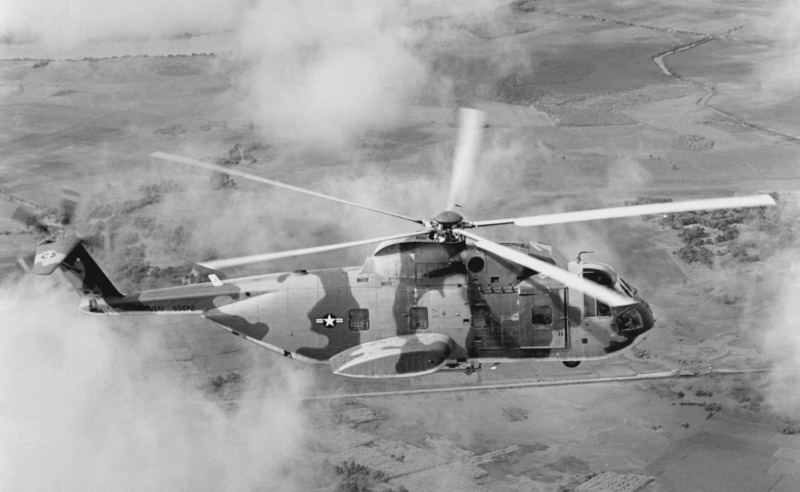
CH-3Cs were used for utility operations in Vietnam; black-painted CH-3Cs were used in the "Pony Express" role, supporting Special Forces commandos operating against the Ho Chi Minh Trail.
A number of CH-3Cs were modified with the MARS system to snag the parachutes of Lighting Bug drones -- modifications, sometimes extensive, of the Ryan Firebee target drone for the reconnaissance mission -- and haul them back to base, the Firebees not having any other way of being recovered safely. The scheme was actually originally developed for recovery of film reconnaissance satellite re-entry vehicles, having been trialed by an SH-3A designated "NH-3A" for the experiment; but the CH-3C was never used for that purpose. The CH-3Cs did perform hundreds of recoveries of Lightning Bug drones.
Other uses of the variant included geodetic survey for the USAF Military Air Transport Service; recovery of balloon-carried weather sondes; and support of the US space program, with a helicopter standing by to recover astronauts or other payloads in case of launch failures. A handful were converted to a CSAR configuration informally designated "HH-3C", by adding armor; M60 7.62-millimeter (0.30-caliber) machine guns on flexible mounts on each side and the rear ramp; additional fuel tankage; and provision for external tanks mounted on the sponsons, each tank with a capacity of 758 liters (200 US gallons). At least one CH-3C was used for trials under the designation of "JCH-3C".
* 75 CH-3Cs were produced, being followed by 42 "CH-3E" helicopters, the primary difference being T58-GE-5 turboshaft engines, equivalent to the US Navy T58-GE-10. CH-3C survivors were mostly upgraded to CH-3E spec; the CH-3Es also saw service in Southeast Asia, being used in most of the same roles as the CH-3Cs, such as Lightning Bug drone recovery.
____________________________________________________________________
SIKORSKY CH-3E (S-61R):
____________________________________________________________________
main rotor diameter:
18.9 meters (62 feet)
tail rotor diameter:
3.15 meters (10 feet 4 inches)
fuselage length:
17.45 meters (57 feet 3 inches)
footprint length:
22.25 meters (73 feet)
height (to top of rotor head):
4.9 meters (16 feet 1 inch)
empty weight:
5,635 kilograms (12,425 pounds)
MTO weight:
10,000 kilograms (22,050 pounds)
max cruise speed:
265 KPH (165 MPH / 145 KT)
service ceiling:
4,145 meters (13,600 feet)
hover ceiling (in ground effect):
2,955 meters (9,700 feet)
hover ceiling (out of ground effect):
915 meters (3,000 feet)
range, max fuel:
780 kilometers (485 MI / 400 NMI)
____________________________________________________________________
Sikorsky designed a remote-control TAT-102 Minigun turret for the CH-3E, similar to that designed for the HH-3A, but mounted on the CH-3E's sponsons. One CH-3E was fitted with the turret; however, it didn't go into service. A number of CH-3Es were fitted out as VIP transports for high US government officials, being informally redesignated "VH-3E".
Six "HH-3E" machines were obtained for CSAR, these machines featuring an extendable probe for inflight refueling; provision for an external tank on each sponson, with a capacity of 758 liters (200 US gallons) each; about 450 kilograms (1,000 pounds) of titanium armor; self-sealing fuel tanks; and defensive armament.
At least 11 CH-3Es were also modified to the HH-3E spec; a CH-3E had been used in initial trials of the inflight refueling probe, the trials said to be the first successful inflight refuelings of a helicopter. In 1967, two HH-3Es performed the first helicopter non-stop Atlantic crossing, being refueled in mid-air multiple times to make the trip.
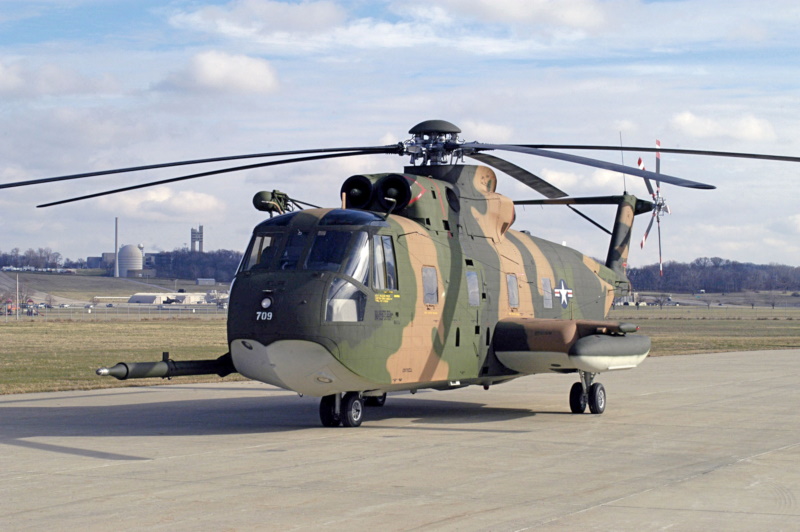
The HH-3Es were used extensively in Southeast Asia, being introduced to the theater in 1965. These machines were painted in jungle camouflage, being employed primarily in the CSAR role to rescue downed pilots. The type became known as the "Jolly Green Giant" -- after a popular advertising icon of the Green Giant vegetables brand. The Jolly Green Giant crews became known for dash, taking extraordinary risks to keep downed pilots out of enemy hands.
* The USCG obtained "HH-3F Pelican" machines for maritime SAR and utility, these being similar to the CH-3E, but with AN/APN-215 radar mounted offset on the nose, and inflatable flotation gear; they were kitted to handle up to 15 stretchers. Flight of the first was in 1967, with 40 produced to 1973. The Coast Guard obtained at least ten used CH-3Es and HH-3Es, some being used as spares hulks, five being generally brought up to HH-3F spec, though without flotation gear.
Sources mention two "S-61NR" machines provided to Argentina, similar to the USCG HH-3F. In addition, the S-61R was license-built by Agusta in Italy as the "AS-61R", with 35 produced for the Italian Air Force for the SAR mission, also being designated "HH-3F". They could be recognized by the obnoxious, bulbous offset nose radome for Ekco 290 radar. The first was delivered in 1977, with the last delivered in the 1990s. In that decade, with overseas interventions by Italian forces, the surviving HH-3Fs were upgraded with new AN/APS-17 radar plus NVG-compatible cockpits, and given disruptive camouflage paint jobs.
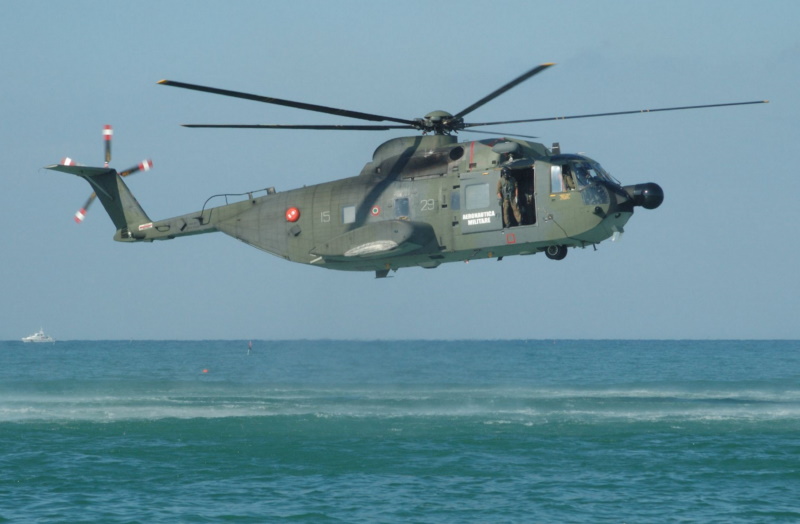
The CH-3E was generally retired from US service during the 1980s, with the HH-3E persisting into the early 1990s. In 1990, five were kitted up for special operations missions, to be informally redesignated "MH-3E", featuring a FLIR imaging turret, a radar warning receiver, and GPS navigation; they had M60 machine guns on pintle mounts on the sides, and an M2 Browning 12.7-millimeter (0.50-caliber) machine gun on a pintle mount in the rear ramp. They were painted in desert camouflage, serving in Operation DESERT STORM.
The last of the HH-3Es were phased out of USAF service in the mid-1990s, being replaced by the Sikorsky HH-60G Pave Hawk. There was interest in the early 1990s in converting surplus CH-3Es to target drones, to be designated "QCH-3E", with 23 set aside for the program -- but the exercise was canceled without any conversions being performed.
The HH-3F was phased out of USCG service in the mid-1990s, being replaced by the Sikorsky HH-60J Jayhawk. The Italian Air Force HH-3Fs saw extensive service in foreign operations, being phased out in 2014, in favor of the AugustaWestland AW139. The S-61R did, however, lead to the more capable Sikorsky S-65 / S-80 series, which remains in widespread service, and indeed is still in production.
BACK_TO_TOP